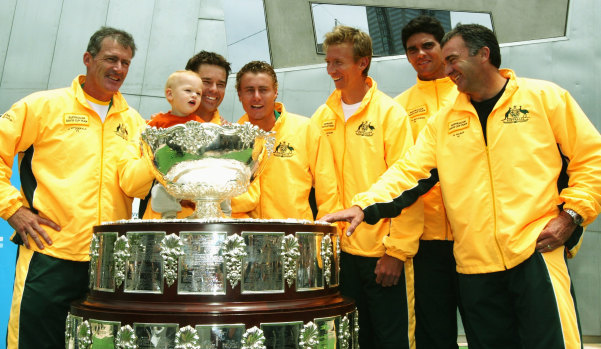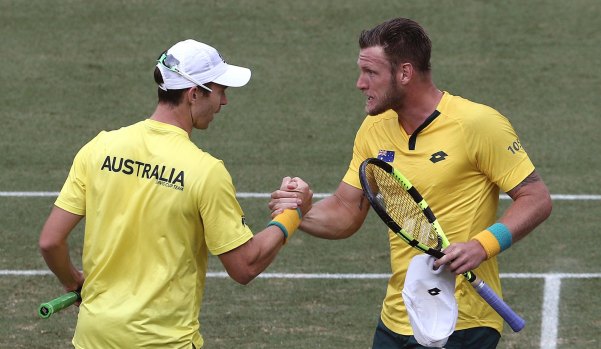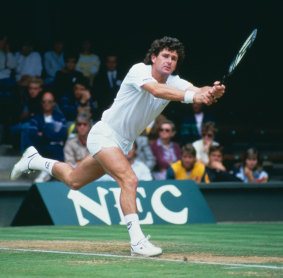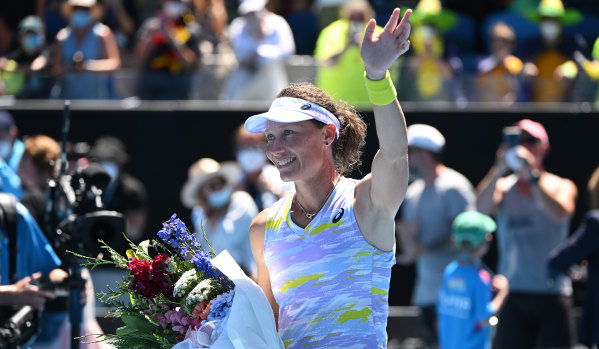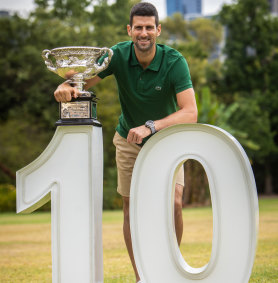Save articles for later
Add articles to your saved list and come back to them any time.
Sam Stosur, Paul McNamee, Wayne Arthurs and Sam Groth have grand slam singles and doubles titles, Davis Cup wins, two Billie Jean King Cup finals and four Newcombe medals between them.
In other words, this Australian tennis quartet, who all took part in this week’s Kooyong Foundation Pro-Am event, have plenty of authority when speaking about the game.
We asked them six topical questions ahead of next month’s Australian Open – and they did not always agree with each other’s answers. From Nick Kyrgios’ future in tennis to the biggest issue affecting the tours, here’s what they said.
What does the future hold for Kyrgios, and will he return to his best?
Kyrgios has been dealing with persistent injuries that have sidelined him for large chunks of time since last summer, and is currently battling a wrist injury. But Arthurs says if Kyrgios wants to apply himself, he can come back to tennis – and there is a slam there for the taking. “We all know he is a talent,” he says. “He’s smart enough to know [Novak] Djokovic is at the end of his career, so there’s a slam there for the taking. By all reports, he was training pretty bloody hard mid-year before he went to Wimbledon and got injured again. But is a 20 per cent Kyrgios going to rock up to the Aussie Open? I don’t think he will play. But by the middle of next year, at Wimbledon, it might be time.”
Whether we will see Kyrgios at his best again is a different matter.
“A year away from sport is a long time,” says Groth, though he concedes it would be bold to predict the mercurial star’s future. “It’s better for the sport when he’s around, in terms of an entertainment product, and hopefully, he can get back and enjoy however long he has left in the sport.”
McNamee is in accord with Arthurs – the 2024 edition of Wimbledon is the soonest we are likely to see Kyrgios at his peak. “I don’t know if he’s going to make it for the Aussie Open or not, I don’t have the insight, but he won’t be at his best. He’s pretty good fresh, though, and he’s a scary draw [for rivals].”
Stosur highlights Kyrgios’ entertainment factor. “From a tournament perspective, of course, you want to see him back out there competing again.”
Should Australia bid to host its round-of-16 group in next year’s Davis Cup finals?
Wayne Arthurs, third from right, flanked by Lleyton Hewitt and Mark Philippoussis, with the 2003 Davis Cup trophy.Credit: Getty Images
This would be played after the US Open in September, ahead of the Asian hardcourt swing – and would clash with the finals series for the AFL and NRL.
But Groth isn’t concerned about competition with other sports and Stosur is confident those who support tennis are different to the crowd that supports the football codes. “Tennis is huge here, and I think if you’ve got an event people want to see, depending on where it is in Australia, I think it could be great,” she says.
Groth’s best Davis Cup memories are of home ties. “I would love to see the Davis Cup come back to Australia,” he says. “Those away ties can be hostile, and you remember them, but my greatest memories were playing at home, in front of home fans. I’d love to see the Davis Cup hosted here again in Melbourne, and for the public to get behind it and support it.”
Australia’s Sam Groth, right, celebrates a Davis Cup doubles win with John Peers in Sydney.Credit: AP
But Arthurs is not convinced. “Is the crowd going to be there? I’m going to say probably not,” he says. “At that time, it’s going to be pretty risky going against such big sports in Australia. If you come here and don’t get the crowd, how’s that going to look? I would love to see it here, and I’d love to see the passion in the crowd, but I really worry about that time of year. I’d hate to see the stands half-full and not passionate.”
McNamee says there’s no reason Melbourne or Sydney would have to host if Australia were to bid. But he doesn’t feel strongly about hosting. “I’m not as passionate about Davis Cup as I was because of the new format but, of course, it’s still got the brand, and we’ve done great to be in the final the last two years, so why not, if that’s what Tennis Australia wants to do? You’d have to ask Lleyton [Hewitt] because he’s still not a fan of the format.”
What do you think about the concept of a ‘premium tour’?
The concept of the top-class tour that has been floated would include only the best players, who would compete in as few as 14 tournaments – including the four slams.
McNamee firmly believes it won’t happen and wasn’t shy in airing his views. “Not only do I not think it will happen, I am not a believer in it either. Philosophically, I’m dead against it,” he says. “Thank goodness the slams are 128-player main draws. People always want to blame the slams, but the slams are keeping the lower guys alive [in the sport].”
Paul McNamee competes at Wimbledon in 1986.Credit: Getty Images
Arthurs describes the proposed tour as elitist and says it would limit the attraction for junior players. “It’s a very difficult sport, it’s very hard to break into it, and as soon as you make it even more elitist, it’s just going to detract from people who want to play the game. It’s a worldwide sport, and if you pigeonhole players into small groups who have to be so good to get to that level, what’s the attraction for kids coming up to want to try and play the game?”
But Groth says anything that drives the sport to be better is a good thing. “I think tennis, in recent times, has done a good job of trying to increase the number of players who can make a living out of the sport. As someone who was in and out of that [top] level, it’s a challenge when you’re in the lower levels, but, at the same time, anything that brings more money to the sport, you hope at some stage that starts to filter down.”
How do you feel about Saudi money coming into tennis?
Stosur did not want to speak on this topic, but Arthurs and McNamee are again in agreement – Saudi investment in tennis is inevitable.
“It’s coming, and there’s nothing we can do to stop it,” Arthurs says. “They’re coming into every sport, and they are going to influence tennis at some capacity. I know they’re looking at possibly getting a Masters event, maybe at the beginning of the year, which will affect the [Australian Open] lead-in tournaments, but you could place them in February. It’s not ideal, obviously, but if you’re trying to expand the sport, the Saudis have a pretty big grip on it – it’s hard to ignore money.”
McNamee says: “It’s in football [soccer], it’s in golf. Of course, it is going to end up in tennis – it’s inevitable. There’s Qatari money, and there’s Abu Dhabi [United Arab Emirates] money as well. That’s where the money in tennis is coming from now, so it’s a fact of life, but I don’t think it will play out as is being speculated.”
Groth says players should be able to decide, though: “I’d like to think sport can be above politics”.
“In the end, most of these athletes are doing this for a career – they’re not doing it to buy into the political situation in any country or another. Whether you can separate the two, that’s for the players to decide when it’s offered to them or not.”
What is one thing you would change about the professional tour?
The answer is unanimous – more opportunities to play.
But our experts’ reasons are different. Stosur wants opportunities for women to match those available for those on the men’s tour.
“There are four or five men’s Challenger [secondary tour] events every week, whereas women have only one,” she says. “There are parts about the tour I don’t like, including the structure of some of these two-week events and how you’re not allowed to have an event up against your Madrids or Beijings. It’s the only event on that week, so unless you are ranked 45 or 50 in the world, you can’t actually play. If you have to play qualifying, and there’s only one event, that’s pretty rough.”
Sam Stosur waves to the crowd after her final Australian Open singles match last year.Credit: Getty Images
For Arthurs, it’s about helping Australians gain ground on those from other countries. “More Challengers within Australia. Italy has 35 Futures, pretty much one a week, all year, and something like 20-plus Challengers – it’s a massive advantage. The US have done the same thing, and they have a slam. We nearly need to give our guys a leg-up, get the guys to 300 [in the rankings], then they go, ‘OK, I’m going to have a real crack at this’.”
McNamee says there are not enough opportunities at the moment for players ranked outside the top 100. “In golf, for example, you have 55 tournaments in Asia, and in tennis you have five. Other sports have 500, 600 or 700 guys making a living. It’s completely wrong [in tennis].”
Who do you think will win the Australian Open?
Novak Djokovic is a 10-time Australian Open men’s singles champion.Credit: Scott McNaughton
In the men’s draw it’s hard for any of our experts to go past Novak Djokovic. But there are some contenders coming up that could provide a challenge – specifically Italian star Jannik Sinner and Carlos Alcaraz.
“It’s pretty hard to go past Novak, especially in Melbourne,” Stosur says. “It might be a Novak-Alcaraz final, but is this Sinner’s chance to break through and win a slam? Let’s go out there and say Sinner is going to get this one.”
McNamee predicts a battle between two.
“You’re not going bold if you say Djokovic or [Carlos] Alcaraz, but it’s going to be one of those two. It’s highly likely it will be Novak, but Alcaraz is a threat,” McNamee says.
Arthurs predicts a Djokovic-Sinner final, while Groth says Djokovic will be hard to beat over five sets. “Jannik Sinner is dangerous, obviously beating Novak twice over a week or so [in November], which is an incredible feat, but it’s a different job to do it over five sets,” says Groth.
The women’s draw is a more open question.
“[Iga] Swiatek cruised through the WTA Finals, and she’s probably the favourite. She’s been the most consistent over the last few years,” says Groth.
But McNamee would be surprised if Swiatek wins. “Aryna Sabalenka is a very good chance,” he says.
Stosur agrees. “I think ‘Sabs’ can maybe do it again. Swiatek has never really shown that this [the Australian Open] is it for her, but by no means does that mean it can’t be, or won’t change. But, I was really impressed with Sabalenka’s year, from start to finish.”
Arthurs goes outside the box in his women’s singles prediction: “I’m going to go [Jessica] Pegula. She’s been around the mark.”
News, results and expert analysis from the weekend of sport sent every Monday. Sign up for our Sport newsletter.
Most Viewed in Sport
From our partners
Source: Read Full Article

